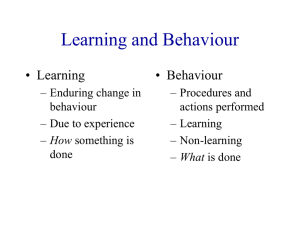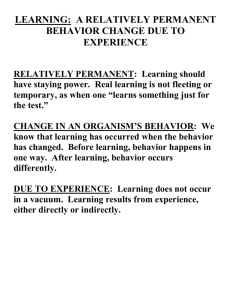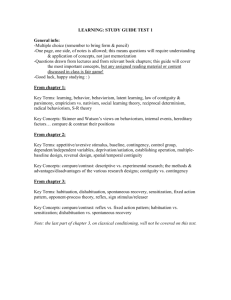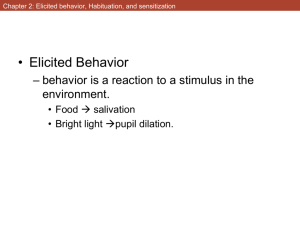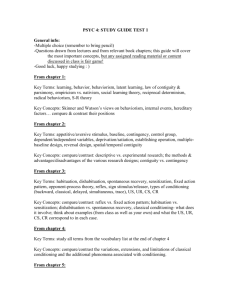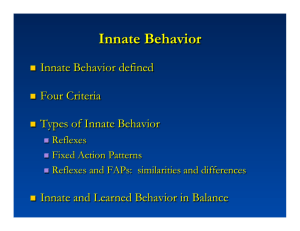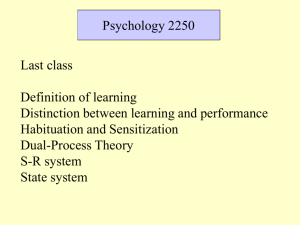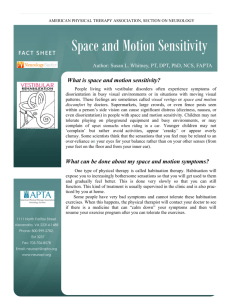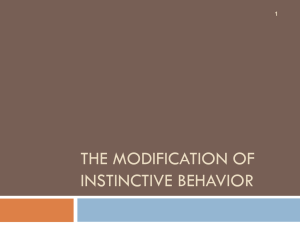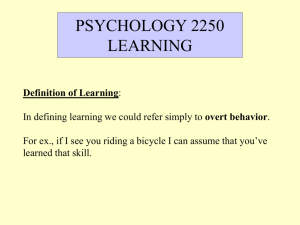Elicited behavior, Habituation, and Sensitization
advertisement
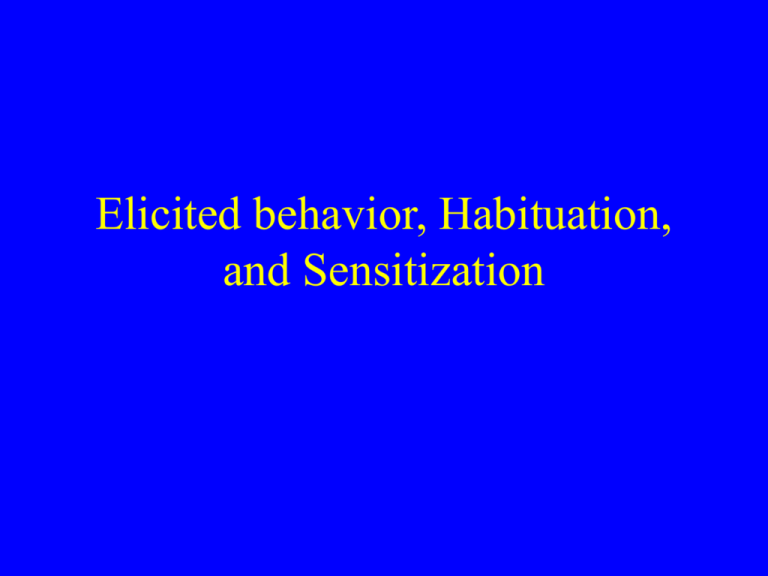
Elicited behavior, Habituation, and Sensitization Non-Associative Learning/Behavior Elicited behavior - reflex, modal action pattern. Repeated stimulation - habituation, sensitization. Emotional behavior - pattern of affective dynamics. Elicited Behavior Reflex - Response elicited by a specific stimulus. Salivation, knee jerk, etc. Elicited Behavior Modal Action Pattern (MAP) – Orderly sequence of reflexive behaviors. Concept put forth by ethologists Tinbergen and Lorenz. Species typical behavior, e.g., feeding, mating, social behaviors, etc. Evolutionarily important behaviors, “instinctive” Elicited by complex array or sequence of stimuli. Elicitation can depend on motivation (“action-specific energy”) Modal Action Pattern Video of egg retrieval in goose What is the sign stimulus? MAPs in Humans? • Lorenz claimed that caring for young (and the associated affective responses) are MAPs. • The sign stimuli are: – – – – – – – – Head large in proportion to the body Protruding forehead large in proportion to the size of the rest of the face Large ears and eyes below the midline of the head Small nose Short thick extremities Rounded body shape Soft elastic body surfaces Round protruding cheeks Stephen Jay Gould on the evolution of Mickey Mouse Supernormal stimulus An accurate 3-dimensional model of a herring gull's head (a), and a 'supernormal' bill (b). Supernormal stimulus Supernormal stimuli? v. Repeated stimulation Repeated stimulation Elicited behavior is not plastic, but can change with repeated stimulation. Habituation effect Decreased response with repeated stimulation. Sensitization effect Increased response with repeated stimulation. Habituation effect Response Trials Habituation movie Rat hears a series of loud bursts of noise Dishabituation Dishabituation effect Response Trials Dishabituation movie Rat hears a series of loud high-pitched noises, Followed by a loud lower-pitched noise, Followed by another series of loud high-pitched noises Spontaneous recovery Retention Interval Response Trials Location of habituation processes Sensory adaptation Habituation Fatigue How is habituation different from sensory adaptation and fatigue? • Sometimes the habituated response will not recover after for a long time. (Long Term Habituation) Day Day 11 Responses to Stimulus Day Day 21 21 Repeated Trials of stim Repeated Trials of stim A • Habituation will be slower for stimuli which have a higher salience (i.e., intensity) Resp Resp to to weak weak coffee coffee flavor flavor Resp Resp to to Strong Strong coffee coffee flavor flavor Responses to Stimulus Repeated Trials Repeated Trials • Dishabituation following the presentation of a novel stimulus. Present Response Response to to Present Stimulus Stimulus B B stimulus stimulus A A (light) (light) (tone) (tone) Responses to Stimulus Response Response to to stimulus stimulus A A (tone) (tone) Repeated Trials • Generalization gradient of a habituated response. Responses to Stimulus 1700 1800 1900 2000 2100 2200 2300 Tone frequency of test stimulus following habituation at 2000 Hz Short-Term v. Long-Term Habituation Days 1 - 11 Leaton (1976) Day 12 Day 13 Sensitization effect Response Trials Sensitization In general Sensitization effects can be influenced by similar parameters as habituation. However, generalization is greater in Sensitization. - Following exposure to cutaneous pain, rats’ reactivity to a wide range of auditory stimuli is increased. Sensitization can be thought of as “arousal”. Sensitization “arousal” effect Sensitization Movie Habituation and Sensitization in Aplysia Sensitization Pathway Increased serotonin release Dual-Process theory of Habituation and Sensitization 2 underlying processes exist – 1) A Habituation process – 2) A Sensitization process The observable behavior is the sum of these two processes. The habituation effect is observed when the habituation process is greater than the sensitization process. Dual Process examples Sensitization effect Habituation effect S S + + NET - - H NET H Trials Trials Groves and Thompson (1970) S-R System: Habituation is thought to occur in the reflex arc. State System: Sensitization is thought to occur in the part of the nervous system that determines general responsiveness. Infant attention Looking Time Trials Emotional responses Opponent Process Theory of Motivation Changes in complex emotional responses Explains: Drug addiction – tolerance and withdrawal (?) Marriage – boredom and bereavement
